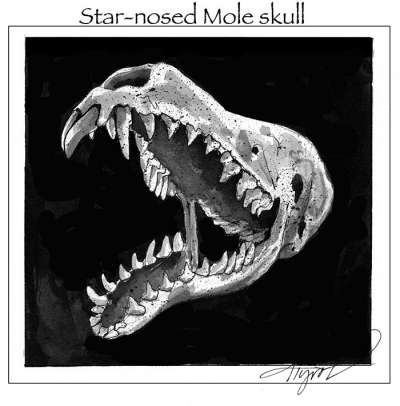
When my daughter was four, she once asked, “Do mice get cavities?” We were coming back from the dentist, so teeth were on her mind and so were mice, since her pet mouse had recently escaped. Later in the day, she asked if ducks had teeth; such is the ranging nature of her intellect.
Why all the toothy questions? Because our teeth are interesting. Ask a dentist. And so are the teeth of our wild neighbors. Teeth can tell a lot about a species’ line of work — particularly what they eat and how they catch their dinner. Teeth are action-oriented; incisors nip and gnaw, canines stab and hold, premolars cut, sheer, slice, and grind, molars mash and crush. Teeth forms hint at a species’ evolutionary story, and crown wear can tell much about the age of an animal. For example, deer and other herbivores that dine on abrasive foods — tree buds, inner bark, seeds, roots and shoots, leaves, woody stems, grasses — show rates of premolar and molar wear that are predictable and measurable. Animals particularly long in tooth may have molars worn down to the bone. Rodents, on the other hand, have “rootless” incisors or molars, and the crowns continue to grow, keeping up with wear. Aging a beaver using incisor wear wouldn’t work for that reason.
Back in college, as a wildlife ecology student, I had to learn how to identify mammal skulls, and teeth cusp patterns were often important clues. Students were encouraged to make our own skull collections. That was the fun part. But what I remember most were hours in the lab at night, learning dental formulas and laboring over rows of small rodent skulls that all looked the same. I passed that class but only by the skin of my teeth.
I had occasion to think about mammal teeth again recently when the snow finally melted off the lawn. That’s a great time to inventory the winter activities of some of the small mammals that make up our backyard biodiversity. Little piles of dirt on top of the dead grass are the leavings of tunneling eastern and star-nosed moles. On rare occasions, I’ve found an expired mole on the surface and been able to examine its teeth. Moles are some of our smallest, most primitive mammals. They live secretive lives. With the adaptation of very large, webbed forefeet, they can tunnel 100 feet a day. Their method of movement is a bit like doing the breaststroke underground.
Did you ever wonder how moles work all that soil up to the surface? Here’s how Alfred J. Godin, author and illustrator of Wild Mammals of New England, describes the process: “When a pile of dirt has accumulated, the mole turns around in a half-somersault and pushes the dirt [to the surface] with one of its forepaws, with the head and shoulders turned to one side.”
Moles eat mostly soft foods. Earthworms make up the majority of their diet. But they also eat a range of insects – adults, larvae, and pupae. Their teeth have to perform a diverse set of functions: first capturing that toothsome worm with backward arching incisors that push it farther back into the mouth cavity; then dicing, slicing, and mashing. The premolars of moles are sharply differentiated from the molars, with ridges shaped like a tiny w.
The other evidence we find at snowmelt is the surface roads of meadow voles. Voles are enthusiastic path-makers that rarely make it into the fortress of the house, unlike white-footed mice, house mice, and deer mice. Instead, they create labyrinthine patterns of shallow runways. Here and there, round balls of dried grass mark their nests, which may be underground as well. Meadow voles, one of the most abundant mammals in New England, are mostly herbivorous, dining on seeds, bark, tubers, grasses, sedges, and grains — i.e., food that does not run away — so most of the work of the teeth is in the crushing action of the molars. These are continuously growing, while their incisors are deeply rooted. The crowns of the molars are intricate, with four triangular-shaped cusps and a posterior loop.
But getting back to the most central questions here: Do mice get cavities and do ducks have teeth? I believe I told my daughter that mice probably don’t get cavities, that dental hygiene is probably the least of their concerns, and that ducks don’t have teeth, though back when birds were deciding whether to be dinosaurs or their own class of animals, they did have teeth — rows of sharp, conical, reptilian teeth. In modern birds, duck’s teeth would be about as rare as hen’s teeth. I think, for a very brief period of time, those answers satisfied her.


Discussion *